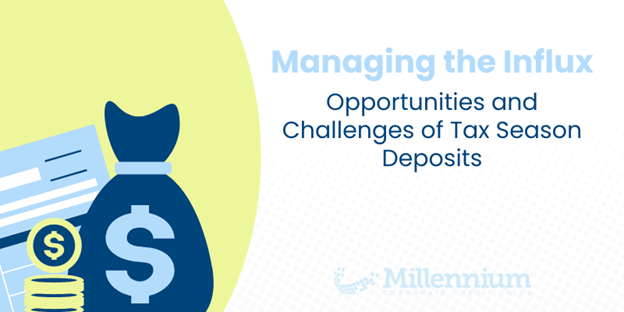
Posted: Mar 13, 2025 | Author: Millennium Corporate
As tax season begins, many Americans receive their tax refunds, leading to a surge in deposits at credit unions. While this influx of cash presents an opportunity for growth, it also poses a challenge in effectively managing and investing these additional funds. With interest rates remaining high in 2025, credit unions have the chance to invest in securities and certificates of deposit (CDs) to maximize returns, but they must also balance this opportunity with the need to maintain liquidity to meet members’ lending needs. Managing these increased deposits strategically is key to ensuring long-term financial health for the organization.
With the entire industry experiencing similar deposit inflows during a similar timeframe, it can cause supply and demand to experience an imbalance. A good example of this is in the CD market. When more financial institutions have higher liquidity, there are more investors and less issuers. All else being equal, this results in lower rates in that market and lower spreads than usual compared to the treasury curve for CDs. Additionally, many CD issuers and buyers move most commonly in 12-month increments. That means there are more investments maturing and repricing around tax season. Which can further impact that previously mentioned imbalance. Similar behavior can be seen in the securities market as well.
Current Rate Environment and Expectations
Market rates remain higher than previously expected and offer credit unions opportunities for investing. The yield curve has flattened out and shows signs of normalizing, which is gaining increasing yield as the term of the investment increases. While it is tough to say where things will go from here, as volatile as the market has been recently, the FOMC dot plot is still forecasting two 0.25% rate cuts in 2025. Regardless of the shape of the yield curve, the focus on building out returning cash flows from the investment portfolio to fund future liquidity needs remains primary.
Strategy for Tax Return Deposits
Many credit unions have seen their investment portfolios shorten in recent years. Much of this is due to continued loan growth and other loan opportunities. This increased demand for lending has caused many credit unions to utilize maturing investments as liquidity sources. This has caused more credit unions to keep elevated balances in their overnight liquidity accounts and a flight towards shorter-term investments. As liquidity has built up and trends have been for less consumer lending demand nationally, it may be time to look at building out the investment portfolio a bit from current levels while still focusing on cashflows and liquidity needs. A good start is by beginning to rebuild that ladder from the current level to a slightly longer timeframe. This will look different for every credit union. However, building out a little longer than the current duration helps position the portfolio for a potentially falling rate environment while also not overly extending to add unnecessary interest rate risk to the balance sheet. Having an outside resource that constantly focuses on investing markets and understands the impact of those investments on your ALM results can be a huge help in making an investment plan that works for your credit union’s unique balance sheet and members.
Maximizing Opportunities
The additional member deposits from tax refunds present a unique opportunity for credit unions in 2025. By carefully investing excess liquidity in CDs, securities, and overnight liquidity, credit unions can benefit from higher returns, build the investment portfolio to facilitate future liquidity needs, and be positioned for various interest rate environment changes. In a market where inflation and interest rates remain key concerns, credit unions’ ability to effectively manage these extra funds will help set them up for the rest of 2025 and future years.
Want to learn more or need help managing the influx? Contact an AIM Team Member or call 855.882.8474


